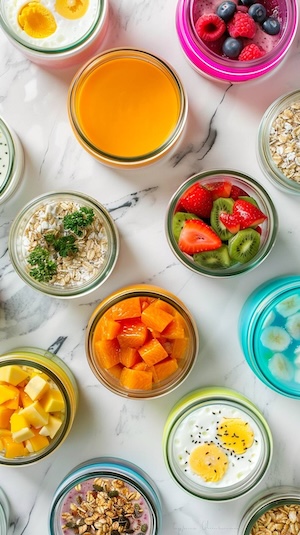PCOS for Picky Eaters: 30 Simple Meal Ideas
Discover 30 simple pcos meals for picky eaters that help manage symptoms. Easy pcos meals picky eaters will love, with practical tips and hormone-balancing ingredients.
Barbecued turkey can be a nice change up fro traditional roasted turkey recipes. Notes: Thaw turkey, if frozen, at least 72 hours in refrigerator. Reserve giblets, neck, and drippings for gravy, if desired.
Transform your health with tailored 7-day meal plans designed specifically for PCOS management. Just $7/month or $59/year.
Get it now →1 turkey (10 to 30 lb.)
Olive or salad oil
Artichoke-Parmesan Sourdough Dressing (optional)
Remove and discard leg truss from turkey. Pull off and discard lumps of fat. Remove giblets and neck. Rinse bird inside and out; pat dry with towels.
If stuffing the turkey: Just before roasting, place turkey on work surface breast side down; lightly fill neck cavity with dressing. Bring neck skin up to cover opening. With a metal skewer, fasten neck skin to back, threading skewer in and out several times through neck and back skin. Turn turkey over and loosely pack body cavity with dressing. If turkey has tail attached, tuck tail into cavity. If there's enough skin to overlap at opening, thread a metal skewer in and out several times to close. Lightly tie ends of drumsticks loosely together with cotton string to keep them from spreading apart or leave untied to allow heat to reach thigh joints more easily. Place any leftover dressing in a baking dish. When turkey is about 30 minutes from being done, bake extra dressing, covered, in a 325 ° or 350 ° oven until hot (at least 150 ° in center), about 40 minutes for 8 cups.
Rub turkey skin with oil. Insert a meat thermometer straight down through the thickest part of the breast to the bone. (If using an instant-read thermometer, insert when checking temperature.)
Cook turkey until thermometer registers 160 °; see below. Baste with dripping, if desired.
To roast, place turkey, breast up, on a V-shaped rack in a 12- by 17-inch roasting pan (or one that is at least 2 in. longer and wider than the bird). Roast in a 325 ° or 350 ° oven, as determined by bird size; see below.
To barbecue with charcoal, use a barbecue (20 to 22 in. wide) with a lid. Mound and ignite 40 charcoal briquets on firegrate. When coals are spotted with gray ash, in about 20 minutes, push equal portions to opposite sides of firegrate. Place a foil or metal drip pan between coals. To each mound of coals, add 5 briquets now and every 30 minutes while cooking.
To barbecue with gas, use a barbecue with indirect heat controls at least 11 in. between burners. Turn all burners to high, close lid, and heat for about 10 minutes. Adjust gas for indirect cooking (heat parallel to sides of bird and not beneath) and set a foil or metal drip pan in center (not over direct heat; if drippings flare when lid is open, add a little water to pan).
Set grill in place. Set turkey, breast up, on grill over drip pan. Cover barbecue and open vents for charcoal. If edges of turkey near gas heat begin to get too dark, slide folded strips of foil between bird and grill.
Transfer cooked turkey to a platter. If bird was stuffed, insert a thermometer into the center of the dressing. It should read at least 160 ° to be bacteria safe. Do not allow stuffing to sit in bird. Cut string from legs. Remove skewer closing body cavity. Scoop dressing out into a bowl. Cut through skin at neck cavity, scoop out dressing and add to bowl. If temperature was below 160 °, heat dressing in a microwave oven at full power (100%), mixing often to distribute heat evenly until it is 160 ° throughout. Cover and keep dressing warm. Keep turkey warm and let stand 15 to 30 minutes.
Carve bird. If thighs are still slightly pink at the joint (typical, if oven roasted), put thighs on a microwave-safe plate in a microwave oven at full power (100%) until pink disappears, 1 to 3 minutes.
Turkey weight with giblets: 10-13 lb. Oven temp.: 350 ° Internal temp.: 160 ° Cooking time: 1 1/2 to 2 1/4 hr.
Turkey weight with giblets: 14-23 lb. Oven temp.: 325 ° Internal temp.: 160 ° Cooking time: 2 to 3 hr.
Turkey weight with giblets: 24-27 lb. Oven temp.: 325 ° Internal temp.: 160 ° Cooking time: 3 to 3 3/4 hr.
Turkey weight with giblets: 28-30 lb. Oven temp.: 325 ° Internal temp.: 160 ° Cooking time: 3 1/2 to 4 1/2 hr.
Nutritional analysis per 1/4 pound boned cooked turkey with skin, based on percentages of white and dark meat in an average bird; nutritional analysis does not include dressing.

You know the drill: Alarm goes off. You hit snooze. Rush around frantically. Skip breakfast AGAIN because there's no time. By 10am, you're hangry, your blood sugar is all over the place, and your PCOS symptoms are already acting up.
Sound familiar?
Finally – a meal prep system designed specifically for women with PCOS who refuse to let chaotic mornings derail their health goals.
In just ONE hour on Sunday, you can transform your entire week:
"I went from skipping breakfast 4 days a week to having delicious, hormone-supporting meals ready every morning. My energy is more stable and my cravings have disappeared!"
– Sarah M.
Stop letting chaotic mornings control your health.
Get your hormone-happy mornings starting this Sunday.
→ Get Your 60-Minute Solution Now
Transform your health with tailored 7-day meal plans designed specifically for PCOS management. Just $7/month or $59/year.
Get it now →Serving Size: 0
| Amount Per ONE Serving | ||
|---|---|---|
| Calories 0 kcal | ||
| Fat 0 g | ||
| Carbohydrate 0 g | ||
| Protein 0 g | ||
💡 Introducing the 10/10 PCOS Solution:
Ten Delicious Crockpot Recipes that take just 10 minutes to prep!
Say goodbye to hours in the kitchen and hello to clean, PCOS-friendly meals made effortlessly.
👉 Click here to grab your 10/10 PCOS Solution today! Try The 10/10 PCOS Solution: Ten Crockpot Recipes That Take Just Ten Minutes to Prep
Managing PCOS can be challenging, but you don't have to do it alone. Join our supportive community to connect with others who understand what you're going through, share tips, and get encouragement. Here's how you can get involved:
Subscribe to our Newsletter: Receive PCOS-friendly recipes, tips, research updates, and more delivered straight to your inbox. Stay informed and empowered with the latest information and support.
Join our Telegram Channel: Stay updated with the latest tips and advice on managing PCOS.
Follow PCOS Meal Planner on Facebook: Engage with our community, participate in discussions, and get support from others.
Break the cycle with the PCOS Meal Planner - your personalized guide to eating better, feeling better, and managing PCOS symptoms. Take control today!

Forget the frustrating cycle of weight loss attempts, endless medications, and living in discomfort. Introducing the PCOS Meal Planner. A meal planning guide that goes beyond temporary fixes to offer a comprehensive strategy, empowering you to ignite a transformation towards lasting health and happiness. Step into a world where you control your PCOS, not the other way around.
Unlock Your PCOS Freedom Now.
Discover 30 simple pcos meals for picky eaters that help manage symptoms. Easy pcos meals picky eaters will love, with practical tips and hormone-balancing ingredients.
Discover 15 delicious overnight oats for PCOS recipes that help balance hormones and manage symptoms. Easy, nutritious breakfast ideas perfect for women with PCOS.
Discover the best cereal for PCOS with our expert rankings. Compare brands, check ingredients, and find PCOS friendly cereal that supports hormonal balance.
Learn how to transition away from fruit when starting a ketogenic diet for PCOS. Discover gradual strategies, fruit alternatives, and practical tips for success.
Discover 5 delicious PCOS banana bread recipes with low-glycemic ingredients. Learn how to make hormone-friendly banana bread that supports blood sugar balance.
Creatine for women with PCOS explained simply. Learn safety, benefits, hormone effects, tips, and how creatine may support PCOS symptoms naturally.
Complete PCOS diet plan with foods to eat, foods to avoid, meal timing, and real results. Learn the science-backed approach to managing PCOS through diet, with 7-day meal plan, grocery list, and step-by-step implementation guide. Based on clinical research and real patient outcomes.
Complete guide to ordering at Wendy's with PCOS. Discover the best protein-focused meals, what to skip, and how to customize orders to keep blood sugar stable. Learn which burgers, salads, and sides work for PCOS, plus complete macros for every menu item and smart swaps to avoid insulin spikes.
Complete guide to ordering at Burger King with PCOS. Discover the best protein-focused meals, what to skip, and how to customize orders to keep blood sugar stable. Learn which burgers, salads, and sides work for PCOS, plus complete macros for every menu item and smart swaps to avoid insulin spikes.